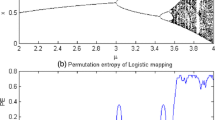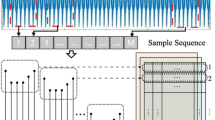Abstract
To quickly and accurately identify lithology, this paper proposes a lithology identification method based on the combination of three-dimensional vibration signal hybrid domain feature and support vector machine (SVM). First, the original signal is divided into several segments by the window function, and the multi-domain features of each segment are extracted respectively to construct a hybrid domain vector; then, the hybrid domain vector is dimensionally reduced by the kernel principal component analysis method, and the principal components with a cumulative contribution rate greater than 90% are selected as the feature parameters, which are input into the SVM model optimized by the gray wolf algorithm for lithology identification. Experiments show that the lithology identification results of the proposed method are consistent with the test rock types, which verifies the feasibility of the proposed method. Compared with other methods, the advantages of the proposed method in classification accuracy and time complexity are verified again.














Similar content being viewed by others
References
Alaa T, Aboul EH (2019) Quantum-behaved particle swarm optimization for parameter optimization of support vector machine. J Classif 36:576–598
Bachmann K, Frenzel M, Krause J, Gutzmer J (2017) Advanced identification and quantification of in-bearing minerals by scanning electron microscope-based image analysis. Microsc Microanal 23:527–537
Bailey SW, Ross DS, Perdrial N, Jercinovic M, Webber J, Bourgault R (2019) Determination of primary mineral content and calcium sources in forest soils using electron probe microanalysis mapping and cluster analysis. Soil Sci Soc Am J 83:1830–1841
Bu CG, Li XF, Sun L, Xia B (2016) Arithmetic solution for the axial vibration of drill string coupling with a down-the-hole hammer in rock drilling. J Vib Control 22:3090–3101
Cai MF, Long XD, Ren FH (2019) Current status and development strategy of metal mines. Chin J Eng 41(4):417–426
Chen SL, Wisinger J, Dunbar B, Propes C (2020) Identification and mitigation of friction- and cutting-action-induced stick/slip vibrations with PDC bits. SPE Drill Complet 35(04):576–587
Dai XW, Huang ZW, Shi HZ, Cheng Z, Xiong C, Wu X, Zhang H (2020) Rock failure analysis based on the cutting force in the single PDC cutter tests. J Pet Sci Eng 194:107339
Falco ID, Pietro GD, Sannino G (2020) Evaluation of artificial intelligence techniques for the classification of different activities of daily living and falls. Neural Comput & Applic 32:747–758
Fatimah A, Peyman M, Pawel S et al (2021) Automated lithology classification from drill core images using convolutional neural networks. J Pet Sci Eng 197:107933
Flegner P, Kačur J, Durdán ML, Laciak M (2019) Processing a measured vibroacoustic signal for rock type recognition in rotary drilling technology. Measurement 134:451–467
Gao XZ, Liu ZJ, Zhang Y et al (2021) Bicycle riding phase recognition of lower limb amputees based on GWO-SVM. J Zhejiang Univ (Eng Sci) 55:648–657
Hitomi K, Kazuhiko N, Kento K et al (2019) Semi-automated scanning electron microscopy energy dispersive X-ray spectrometry forensic analysis of soil samples. Forensic Sci Int 305:109947
Hu JR, Lv ZY (2017) Model validation metod with multivariate output based on kernel principal component analysis. J Beijing Univ Aeronaut Astronaut 43:1470–1480
Huo FC, Li A, Zhao XQ, Ren W, Dong H, Yang J (2021) Novel lithology identification method for drilling cuttings under PDC bit condition. J Pet Sci Eng 205:108898
Isaka K, Tsumura K, Watanabe T, Toyama W, Okui M, Yoshida H, Nakamura T (2018) Soil discharging mechanism utilizing water jetting to improve excavation depth for seabed drilling explorer. IEEE Access 8:28560–28570
Ji C, Yu K, Wei XZ et al (2021) Active domain adaptation with application to intelligent logging lithology identification. IEEE Trans Cybern: to be published. https://doi.org/10.1109/TCYB.2021.3049609
Kaisa L, Riku H, Leena L et al (2021) Convolutional neural network-based artificial intelligence for classification of protein localization patterns. Biomolecules 11(2):264
Kang HP, Wang GF, Jiang PF et al (2018) Conception for strata control and intelligent mining technology in deep coal mines with depth more than 1000m. J China Coal Soc 43(07):1789–1800
Kumar BR, Vardhan H, Govindaraj M (2011) Sound level produced during rock drilling Vis-à-Vis rock properties. Eng Geol 123(4):333–337
Kumar BR, Vardhan H, Govindaraj M, Saraswathi SP (2013) Artificial neural network model for prediction of rock properties from sound level produced during drilling. Geomech Geoengin 8(1):53–61
Kumar CV, Vardhan H, Murthy CS et al (2019) Estimating rock properties using sound signal dominant frequencies during diamond core drilling operations. J Rock Mech Geotech Eng 11(4):850–859
Kumar CV, Harsha V, Murthy CS (2021) Artificial neural network for prediction of rock properties using acoustic frequencies recorded during rock drilling operations. Model Earth Syst Environ 326:1–21
Li ZR, Kang Y, Feng DY, Wang XM, Lv W, Chang J, Zheng WX (2020a) Semi-supervised learning for lithology identification using laplacian support vector machine. J Pet Sci Eng 195:107510
Li ZT, Wang S, Wang JC (2020b) Study on the effect of mineral particle sizes on the spectral characteristics of sound and vibrations in rock drilling. Shock Vib 2020:9036371
Liang JZ, Huang XS, Wu LJ et al (2020) Clustering method of power load profiles based on KPCA and improved K-means. J South China Univ Technol (Nat Sci Ed) 48:143–150
Na L (2021) Simulation of English feature recognition based on machine learning and artificial intelligence technology. J Ambient Intell Humaniz Comput: to be published. https://doi.org/10.1007/s12652-021-03068-1
Niu C, He LN (2021) Research on athlete recognition based on image feature extraction and artificial intelligence classification. J Ambient Intell Humaniz Comput: to be published. https://doi.org/10.1007/s12652-021-03152-6
Olalere O, Stephen B (2020) Application of specific energy for lithology identification. J Pet Sci Eng 184:106402
Perrone D, Jasechk S (2019) Deeper well drilling an unsustainable stopgap to groundwater depletion. Nature Sustainability 2:773–782
Piri M, Mikaeil R, Hashemolhosseini H (2021) Study of the effect of drill bits hardness, drilling machine operating parameters and rock mechanical parameters on noise level in hard rock drilling process. Measurement 167(1):108447
Sun J, Li Q, Chen MQ, Ren L, Huang G, Li C, Zhang Z (2019) Optimization of models for a rapid identification of lithology while drilling - a win-win strategy based on machine learning. J Pet Sci Eng 176:321–341
Sun ZX, Jiang BS, Li XL, Li J, Xiao K (2020) A data-driven approach for lithology identification based on parameter-optimized ensemble learning. Energies 13(15):3903
Sun J, Chen MQ, Li Q, Ren L, Dou M, Zhang J (2021) A new method for predicting formation lithology while drilling at horizontal well bit. J Pet Sci Eng 196:107955
Wan L, Gong LY, Jia MR (2019) Structural damage identification of intelligent composite materials based on principal component analysis. J Text Res 40:53–58
Wang K, Liu G, Li YC, Wang G, Feng K, Yi L (2019) Vibration sensor approaches for experimental studies of sand detection carried in gas and droplets. Powder Technol 352:386–396
Wang K, Hu YN, Yang K, Qin M, Li Y, Liu G, Wang G (2020) Experimental evaluation of rock disintegration detection in drilling by a new acoustic sensor method. J Pet Sci Eng 195:107853
Xie LT, Yan P, Lu WB, Chen M, Wang GH (2018a) Effects of strain energy adjustment: a case study of rock failure modes during deep tunnel excavation with different methods. KSCE J Civ Eng 22:4143–4154
Xie YX, Zhu CY, Zhou W, Li Z, Liu X, Tu M (2018b) Evaluation of machine learning methods for formation lithology identification: a comparison of tuning processes and model performances. J Pet Sci Eng 160(2):182–193
Xu ZH, Ma W, Lin P, Shi H, Pan D, Liu T (2021) Deep learning of rock images for intelligent lithology identification. Comput Geosci 154:104799
Yang YX, Yang Y, Ren HT, Qi Q, Chen X (2020) Research on the working mechanism of the PDC drill bit in compound drilling. J Pet Sci Eng 185:106647
Yuan LH, Lian DS, Zhang L et al (2021) Fault diagnosis of key mechanical components of aircraft based on densenet and support vector machine. J Jilin Univ (Eng Technol Ed) 51:1635–1641
Zhang CF, Yu J, Hao LN (2017) Lithology extraction from synergies muti-scale texture and muti-spectra images. Geological Sci Technol Inf 36:236–243
Zhang Q, Liu ZH, Wang HJ et al (2018) Application of BP neural network in failure identification of pick alloy head. J Vib Meas Diagn 38:508–516
Zhang H, Chen QH, Ni PB et al (2021) Study on the intelligent identification method of formation lithology by element and gamma spectrum. Neural Comput Appl 132:1–9
Acknowledgments
The authors would like to thank the chang’an University Ph.D. Candidates’ Innovative Ability Cultivation Funding Project (No. 300203211252).
Author information
Authors and Affiliations
Corresponding author
Ethics declarations
Competing interests
The authors declare that they have no known competing financial interests or personal relationships that could have appeared to influence the work reported in this paper.
Additional information
Communicated by: H. Babaie
Publisher’s note
Springer Nature remains neutral with regard to jurisdictional claims in published maps and institutional affiliations.
Rights and permissions
About this article
Cite this article
Gao, K., Jiao, S. Research on lithology identification based on multi-sensor hybrid domain information fusion and support vector machine. Earth Sci Inform 15, 1101–1113 (2022). https://doi.org/10.1007/s12145-022-00795-7
Received:
Accepted:
Published:
Issue Date:
DOI: https://doi.org/10.1007/s12145-022-00795-7




